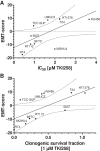Epithelial mesenchymal transition status is associated with anti-cancer responses towards receptor tyrosine-kinase inhibition by dovitinib in human bladder cancer cells
- PMID: 24325461
- PMCID: PMC3866461
- DOI: 10.1186/1471-2407-13-589
Epithelial mesenchymal transition status is associated with anti-cancer responses towards receptor tyrosine-kinase inhibition by dovitinib in human bladder cancer cells
Abstract
Background: Dovitinib (TKI-258) is a receptor tyrosine kinase (RTK) inhibitor targeting fibroblast growth factor receptor (FGFR) and further related RTKs. TKI-258 is under investigation as anticancer drug for the treatment of various cancers including bladder cancer with aberrant RTK signaling. Here, we analyzed the responses of ten human bladder cancer cell lines towards TKI-258 treatment in relation to the epithelial mesenchymal transition (EMT) status of the cells.
Methods: Expression of epithelial marker E-cadherin as well as mesenchymal markers N-cadherin and vimentin was determined by quantitative RT-PCR and Western-blot in RNA and protein extracts from the cultured cell lines. The cell responses were analyzed upon addition of TKI-258 by viability/proliferation (XTT assay) and colony formation assay for measurement of cell contact independent growth.
Results: The investigated bladder cancer cell lines turned out to display quite different EMT patterns as indicated by the abundance of E-cadherin or N-cadherin and vimentin. Protein and mRNA levels of the respective components strongly correlated. Based on E-cadherin and N-cadherin mRNA levels that were expressed approximately mutual exclusively, an EMT-score was calculated for each cell line. A high EMT-score indicated mesenchymal-like cells and a low EMT-score epithelial-like cells. Then, we determined the IC₅₀ values for TKI-258 by dose response curves (0-12 μM TKI-258) in XTT assays for each cell line. Also, we measured the clonogenic survival fraction after adding TKI-258 (1 μM) by colony formation assay. We observed significant correlations between EMT-score and IC₅₀ values (r = 0.637, p = 0.0474) and between EMT-score and clonogenic survival fraction (r = 0.635, p = 0.0483) as analyzed by linear regression analyses.
Conclusions: In sum, we demonstrated that the EMT status based on E-cadherin and N-cadherin mRNA levels may be useful to predict responses towards TKI-258 treatment in bladder cancer.
Figures







Similar articles
-
Effects of multi and selective targeted tyrosine kinase inhibitors on function and signaling of different bladder cancer cells.Biomed Pharmacother. 2018 Oct;106:316-325. doi: 10.1016/j.biopha.2018.06.110. Epub 2018 Jul 11. Biomed Pharmacother. 2018. PMID: 29966976
-
The role of Axl in drug resistance and epithelial-to-mesenchymal transition of non-small cell lung carcinoma.Int J Clin Exp Pathol. 2014 Sep 15;7(10):6653-61. eCollection 2014. Int J Clin Exp Pathol. 2014. PMID: 25400744 Free PMC article.
-
Oncogenic ALK regulates EMT in non-small cell lung carcinoma through repression of the epithelial splicing regulatory protein 1.Oncotarget. 2016 May 31;7(22):33316-30. doi: 10.18632/oncotarget.8955. Oncotarget. 2016. PMID: 27119231 Free PMC article.
-
The role of EPH receptors in cancer-related epithelial-mesenchymal transition.Chin J Cancer. 2014 May;33(5):231-40. doi: 10.5732/cjc.013.10108. Epub 2013 Oct 9. Chin J Cancer. 2014. PMID: 24103789 Free PMC article. Review.
-
Epithelial-to-mesenchymal transition: lessons from development, insights into cancer and the potential of EMT-subtype based therapeutic intervention.Phys Biol. 2019 May 7;16(4):041004. doi: 10.1088/1478-3975/ab157a. Phys Biol. 2019. PMID: 30939460 Review.
Cited by
-
Cigarette smoke induced urocystic epithelial mesenchymal transition via MAPK pathways.Oncotarget. 2017 Jan 31;8(5):8791-8800. doi: 10.18632/oncotarget.14456. Oncotarget. 2017. PMID: 28060741 Free PMC article.
-
Downregulation of DOCK1 sensitizes bladder cancer cells to cisplatin through preventing epithelial-mesenchymal transition.Drug Des Devel Ther. 2016 Sep 8;10:2845-2853. doi: 10.2147/DDDT.S101998. eCollection 2016. Drug Des Devel Ther. 2016. PMID: 27660415 Free PMC article.
-
OVOL2 links stemness and metastasis via fine-tuning epithelial-mesenchymal transition in nasopharyngeal carcinoma.Theranostics. 2018 Mar 8;8(8):2202-2216. doi: 10.7150/thno.24003. eCollection 2018. Theranostics. 2018. PMID: 29721073 Free PMC article.
-
Epithelial-mesenchymal transition confers resistance to selective FGFR inhibitors in SNU-16 gastric cancer cells.Gastric Cancer. 2016 Jan;19(1):53-62. doi: 10.1007/s10120-014-0444-1. Epub 2014 Nov 19. Gastric Cancer. 2016. PMID: 25407459 Free PMC article.
-
Benzo(a)pyrene enhances the EMT-associated migration of lung adenocarcinoma A549 cells by upregulating Twist1.Oncol Rep. 2017 Oct;38(4):2141-2147. doi: 10.3892/or.2017.5874. Epub 2017 Aug 3. Oncol Rep. 2017. PMID: 28791412 Free PMC article.
References
-
- Diez de Medina SG, Chopin D, el Marjou A, Delouvee A, LaRochelle WJ, Hoznek A, Abbou C, Aaronson SA, Thiery JP, Radvanyi F. Decreased expression of keratinocyte growth factor receptor in a subset of human transitional cell bladder carcinomas. Oncogene. 1997;14(3):323–330. doi: 10.1038/sj.onc.1200830. - DOI - PubMed
Publication types
MeSH terms
Substances
LinkOut - more resources
Full Text Sources
Other Literature Sources
Research Materials
Miscellaneous

